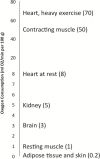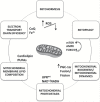Reconsidering the Role of Mitochondria in Aging
- PMID: 25995290
- PMCID: PMC4612387
- DOI: 10.1093/gerona/glv070
Reconsidering the Role of Mitochondria in Aging
Abstract
Background: Mitochondrial dysfunction has long been considered a major contributor to aging and age-related diseases. Harman's Mitochondrial Free Radical Theory of Aging postulated that somatic mitochondrial DNA mutations that accumulate over the life span cause excessive production of reactive oxygen species that damage macromolecules and impair cell and tissue function. Indeed, studies have shown that maximal oxidative capacity declines with age while reactive oxygen species production increases. Harman's hypothesis has been seriously challenged by recent studies showing that reactive oxygen species evoke metabolic health and longevity, perhaps through hormetic mechanisms that include autophagy. The purpose of this review is to scan the ever-growing literature on mitochondria from the perspective of aging research and try to identify priority questions that should be addressed in future research.
Methods: A systematic search of peer-reviewed studies was performed using PubMed. Search terms included (i) mitochondria or mitochondrial; (ii) aging, ageing, older adults or elderly; and (iii) reactive oxygen species, mitochondria dynamics, mitochondrial proteostasis, cytosol, mitochondrial-associated membranes, redox homeostasis, electron transport chain, electron transport chain efficiency, epigenetic regulation, DNA heteroplasmy.
Results: The importance of mitochondrial biology as a trait d'union between the basic biology of aging and the pathogenesis of age-related diseases is stronger than ever, although the emphasis has moved from reactive oxygen species production to other aspects of mitochondrial physiology, including mitochondrial biogenesis and turnover, energy sensing, apoptosis, senescence, and calcium dynamics.
Conclusions: Mitochondria could play a key role in the pathophysiology of aging or in the earlier stages of some events that lead to the aging phenotype. Therefore, mitochondria will increasingly be targeted to prevent and treat chronic diseases and to promote healthy aging.
Keywords: Aging; Lifespan; Mitochondria.
Published by Oxford University Press on behalf of the Gerontological Society of America 2015.
Figures




References
-
- Harman D. Free radical theory of aging: dietary implications. Am J Clin Nutr. 1972;25(8):839–843. - PubMed
-
- Larsson N-G. Somatic mitochondrial DNA mutations in mammalian aging. Annu Rev Biochem. 2010;79:683–706. 10.1146/annurev-biochem-060408-093701 - PubMed
-
- Wanagat J, Cao Z, Pathare P, Aiken JM. Mitochondrial DNA deletion mutations colocalize with segmental electron transport system abnormalities, muscle fiber atrophy, fiber splitting, and oxidative damage in sarcopenia. FASEB J. 2001;15(2):322–332. - PubMed
Publication types
MeSH terms
Substances
Grants and funding
LinkOut - more resources
Full Text Sources
Other Literature Sources
Medical

